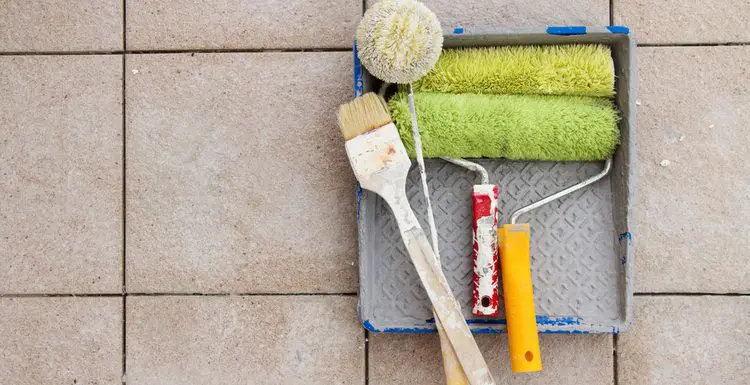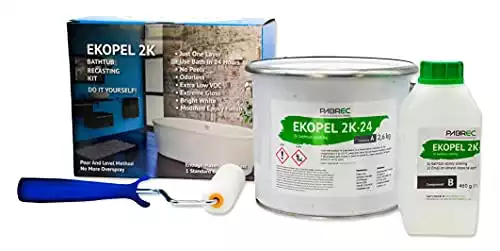Can you paint bathroom tile? So, what’s the best way to do it?
If you’re asking either of these questions, you’re in the right place. We’ll answer these two questions in our complete step-by-step guide.
Read on to learn more.
Can You Paint the Bathroom Tile?
It’s possible to paint bathroom tiles. Yet, some types of paint don’t work well on ceramic.
To paint bathroom tile, you need to prepare the tiles and choose the right type of paint.
How to Paint Bathroom Tile in 6 Steps
Painting bathroom tile is not as easy as painting the walls of your bathroom. Tile is typically made of ceramic and other non-porous materials, making it difficult for paint to adhere to the surface.
Bathroom tile also often has a glaze to protect against water, mold, bacteria, and scratches.
Use the following steps to paint bathroom tile for better results:
- Choose the right type of paint
- Prepare your work area
- Clean and sand the tile
- Apply a primer to the tile
- Apply multiple coats of paint
The most important steps are preparing the tile and selecting the right paint. Without these steps, the paint may wear off quickly, especially in areas that collect a lot of water, such as near the tub.
1. Choose the Right Type of Paint for Bathroom Tile
In most cases, you should use paint that is specially formulated for the tile to keep the paint from peeling off.
You may also use different types of paint based on the type of material. Some of the most common types of bathroom tile include:
- Ceramic
- Glass
- Vinyl
- Laminate
- Stone
Paint that’s formulated for use on tile is typically water-based. Water-based paints hold up better in the humid conditions of the typical bathroom.
If you plan on painting bathroom floor tiles, consider using water-based paints intended for high-traffic areas.
For example, you could use paint intended for exterior use, such as on decks and porches. Water-based paint includes acrylic and latex paints. Acrylic paint is more flexible, decreasing the risk of peeling and cracking.
Latex paint dries quickly and doesn’t produce volatile chemicals, making it easier and safer to use in small spaces.
Yet, acrylic paint works better on certain types of materials. Epoxy paint is an alternative to latex and acrylic paints. Epoxy paints come in two parts.
You mix the two parts several minutes before painting. The mixture dries to provide a solid finish that is less likely to scratch, crack, or peel. However, it’s also more difficult to apply to walls.
Ceramic Tile
Latex paint is typically used to paint ceramic tile. It adheres to the ceramic surface better and offers fuller coverage. You can achieve a smooth finish with fewer coats.
Glass Tile
Acrylic is typically the best choice for painting glass tiles. However, standard acrylic paint may easily scratch when painted on glass.
Instead of standard acrylic paint, look for acrylic enamel paint. The enamel increases the elasticity of the paint. Unlike standard acrylic paint, acrylic enamel paint is entirely water-based and doesn’t contain chemicals.
Vinyl or Laminate Tile
Acrylic paint is too thin to cover vinyl or laminate tile without many coats, which can also result in a tacky surface. Latex paint works better but may wear easily if used on flooring.
As vinyl and laminate tiles are typically used for flooring, consider using latex floor paint instead of standard wall paint. Floor paint is made to hold up to foot traffic.
Stone Bathroom Tile
Due to the porous texture of stone, latex paint tends to work best on stone tiles. Latex is also more durable and less likely to fade when used on stone bathroom tiles.
The latex paint should be formulated for use on interior masonry or stucco.
You can find latex paint in a variety of sheens, from high gloss to flat. A glossy finish is shiny and slippery, while flat finishes tend to provide a little bit of traction.
2. Prepare Your Work Area
Prepare the area that you want to paint by clearing everything out of the way.
Pack up the bathroom supplies and remove any rugs or shower curtains that may get in the way. Open windows and doors.
Cleaning, sanding, and painting may stir up debris or release chemicals that could pose a health risk. Wearing a dust mask and turning on a fan facing out of the bathroom may also help keep you from inhaling dust and debris.
3. Clean and Sand the Tile Before Painting
Thoroughly clean the tile that you plan on painting. You may need to use abrasive bathroom cleaners to get rid of stubborn grease.
Get rid of all dirt, hair, and soap scum. After removing debris, wipe the tile and grout with a damp sponge.
The sponge helps collect any remaining residue. Wipe the surface dry with a clean rag before sanding the tile.
Sanding is necessary for most types of bathroom tiles, including ceramic, laminate, and vinyl. You don’t need to sand glass or stone tiles.
Use a fine-grit (180 to 220 grit) sandpaper to remove the glaze from ceramic tiles.
Sanding laminate and vinyl tile scuffs the surface to help the paint adhere better. If you want to get the job done faster, use a handheld orbital sander or palm sander.
A floor sander is also helpful when painting tile flooring. Whether you use sandpaper or a sander, sand lightly.
Sanding lightly keeps you from removing too much material or damaging the tile. Wipe the surface with a damp cloth after sanding to remove dust. Allow the surface to dry completely before moving on to the next step.
4. Apply a Primer to the Bathroom Tile
No matter the type of bathroom tile, you should always apply a primer before painting. However, before applying primer to stone tile, you need to seal the stone with a sealant.
Using a sealant on stone tile gives the primer and paint a less porous surface for a smoother finish. The paint also clings to the surface, keeping it from peeling off.
The type of primer that you use should match the paint. For example, if you plan on using latex paint, look for a latex primer. If you want to use acrylic paint, use an acrylic primer. The primer should also be made specifically for use on tiles.
Apply the primer to the tile and allow it to dry. The primer container should list the recommended drying time, which is typically between one and four hours.
5. Apply Multiple Coats of Paint to the Tile
After allowing the primer to dry, apply your first coat of paint. If you’re using epoxy paint, you may only need a single coat.
Latex and acrylic paints are likely to require at least two coats. Allow each coat to dry before adding another.
6. Can You Paint the Grout Between Bathroom Tiles?
Yes, you can paint the grout. When painting bathroom tiles, don’t tape off the grout. Paint the entire surface to create an even look.
Make sure that the grout is as clean as possible before painting. You may trap dirt or mildew under the paint, allowing mold to spread.
So, Can You Paint Bathroom Tile?
To paint bathroom tile, you first need to clean, sand, and wipe the surface. Apply a primer before painting the tile.
If you’re painting stone, you may want to add a sealant to create a smoother finish. As a final tip, use a brush to paint the grout, followed by a roller across the tile to eliminate brushstrokes.


